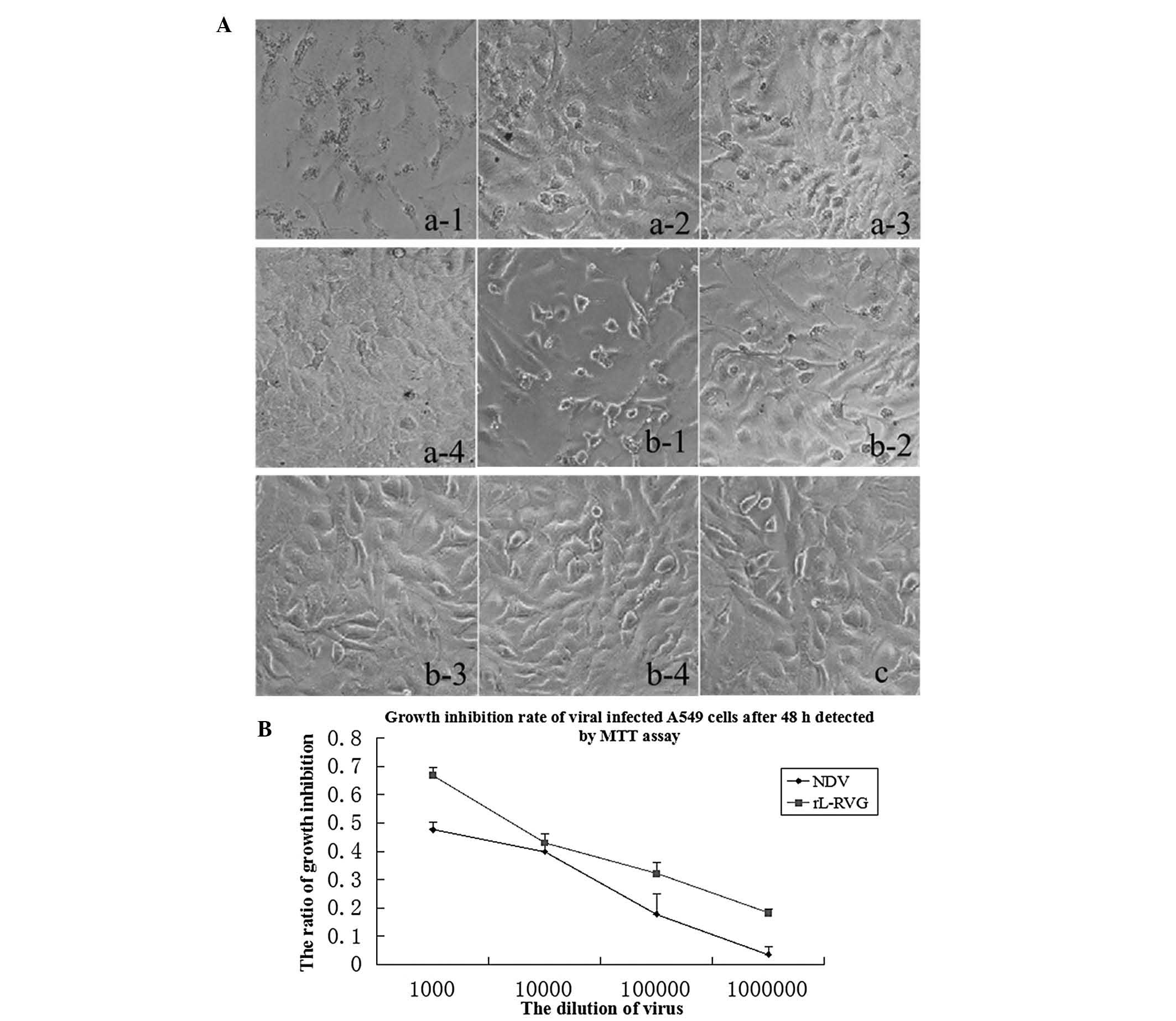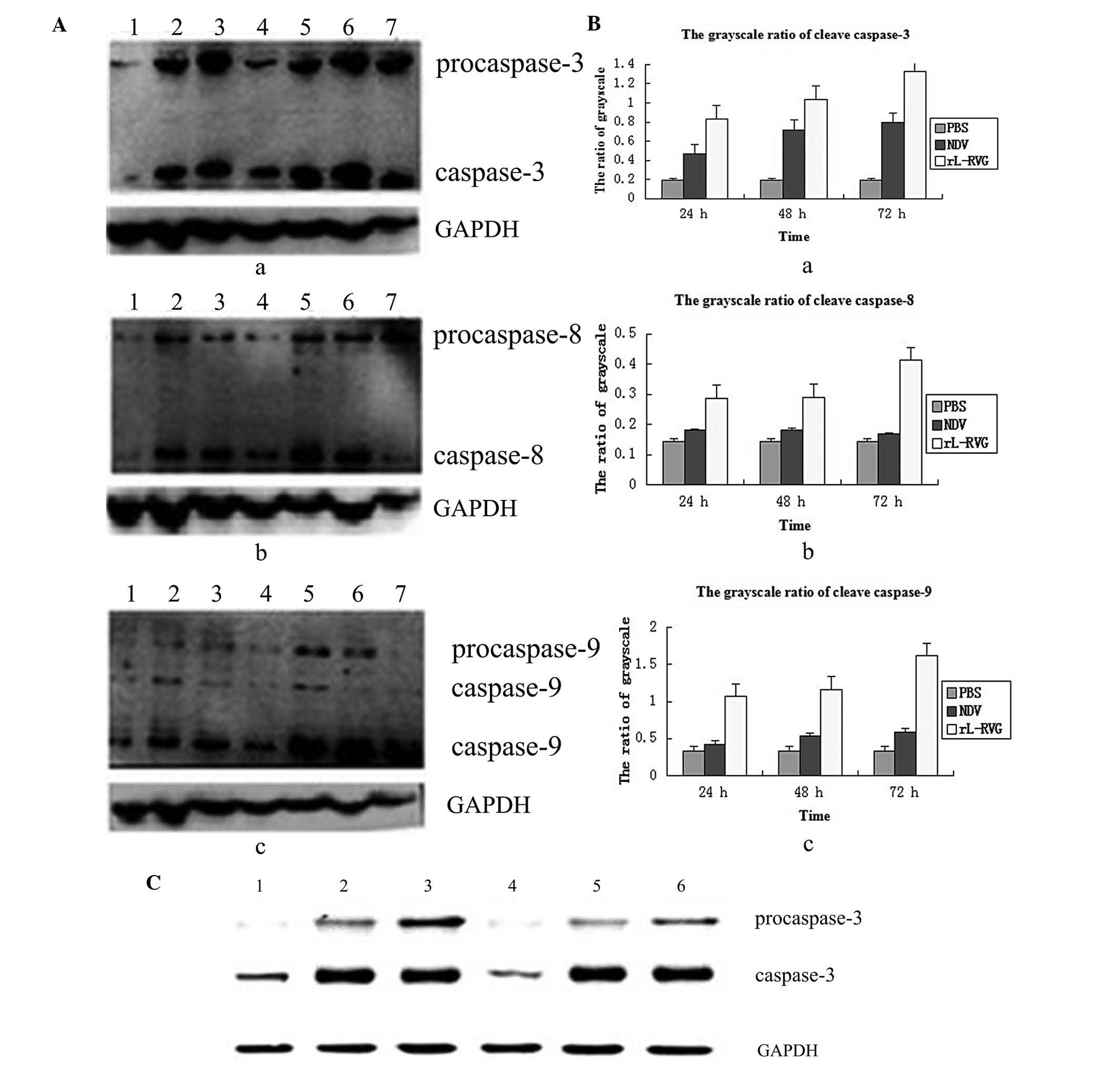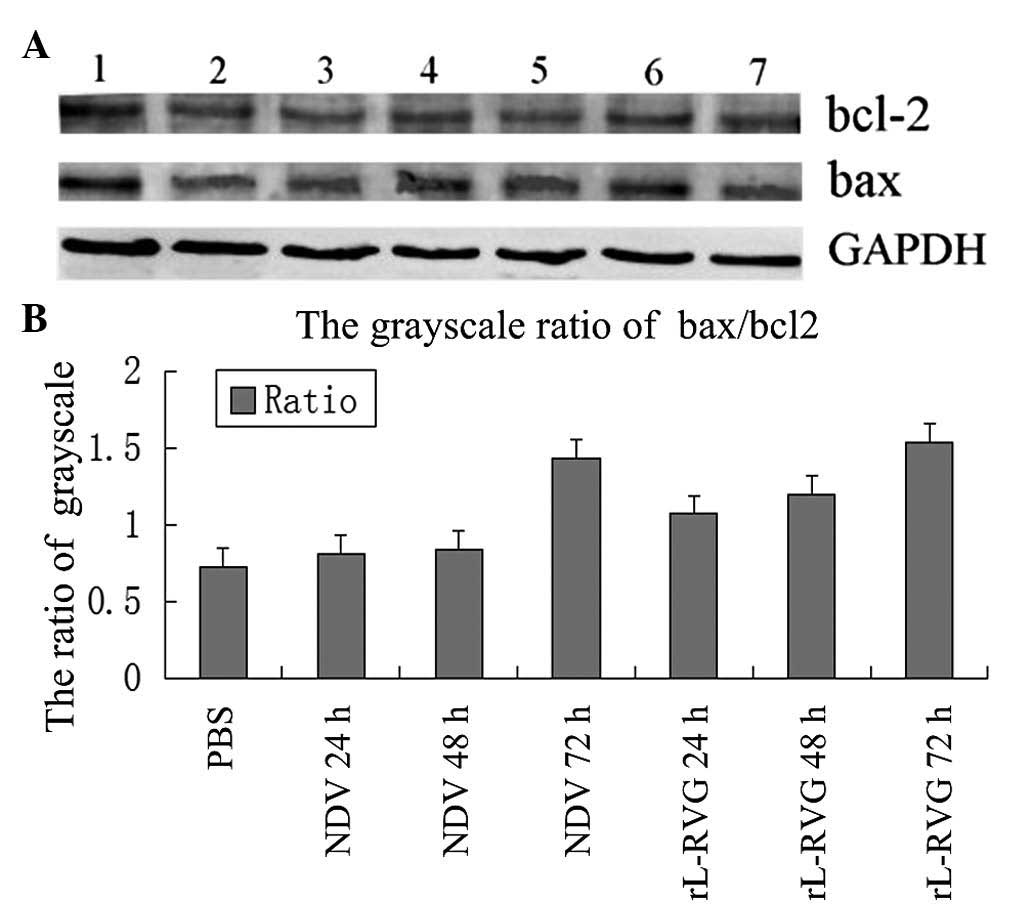|
1
|
Jemal A, Tiwari RC, Murray T, et al:
American Cancer Society: Cancer statistics, 2004. CA Cancer J Clin.
54:8–29. 2004. View Article : Google Scholar
|
|
2
|
DeSantis C, Naishadham D and Jemal A:
Cancer statistics for African Americans, 2013. CA Cancer J Clin.
63:151–166. 2013. View Article : Google Scholar : PubMed/NCBI
|
|
3
|
Zhang J: The treatment of lung carcinoma
in aged people. Chin J Geriatr. 4:316–318. 2001.
|
|
4
|
Vähä-Koskela MJ, Heikkilä JE and Hinkkanen
AE: Oncolytic viruses in cancer therapy. Cancer Letters.
254:178–216. 2007.
|
|
5
|
Lam HY, Yeap SK, Rasoli M, et al: Safety
and clinical usage of newcastle disease virus in cancer therapy. J
Biomed Biotechnol. 2011:7187102011.PubMed/NCBI
|
|
6
|
Yusoff K and Tan WS: Newcastle disease
virus: macromolecules and opportunities. Avian Pathol. 30:439–455.
2001. View Article : Google Scholar : PubMed/NCBI
|
|
7
|
Römer-Oberdörfer A, Werner O, Veits J,
Mebatsion T and Mettenleiter TC: Contribution of the length of the
HN protein and the sequence of the F protein cleavage site to
Newcastle disease virus pathogenicity. J Gen Virol. 84(Pt 11):
3121–3129. 2003.PubMed/NCBI
|
|
8
|
Wu Y, Zhang X, Wang X, Wang L, Hu S, Liu X
and Meng S: Apoptin enhances the oncolytic properties of Newcastle
disease virus. Intervirology. 55:276–86. 2012.PubMed/NCBI
|
|
9
|
Silverstein SC and Marcus PI: Early stages
of newcastle disease virus-hela cell interaction: an electron
microscopic study. Virology. 23:370–380. 1964. View Article : Google Scholar : PubMed/NCBI
|
|
10
|
Johnson N, McElhinney LM, Smith J, Lowings
P and Fooks AR: Phylogenetic comparison of the genus lyssavirus
using distal coding sequences of the glycoprotein and nucleoprotein
genes. Arch Virol. 147:2111–2123. 2002. View Article : Google Scholar
|
|
11
|
Préhaud C, Lay S, Dietzschold B and Lafon
M: Glycoprotein of nonpathogenic rabies viruses is a key
determinant of human cell apoptosis. J Virol. 77:10537–10547.
2003.PubMed/NCBI
|
|
12
|
Ge J, Wang X, Tao L, et al: Newcastle
disease virus-vectored rabies vaccine is safe, highly immunogenic,
and provides long-lasting protection in dogs and cats. J Virol.
85:8241–8252. 2011. View Article : Google Scholar : PubMed/NCBI
|
|
13
|
Reed LJ and Muench H: A simple method of
estimating fifty percent endpoints. Am J Hyg. 27:493–497. 1938.
|
|
14
|
Molouki A, Hsu YT, Jahanshiri F, Rosli R
and Yusoff K: Newcastle disease virus infection promotes bax
redistribution to mitochondria and cell death in HeLa cells.
Intervirology. 53:87–94. 2010. View Article : Google Scholar : PubMed/NCBI
|
|
15
|
Ali R, Alabsi AM, Ali AM, et al: Cytolytic
effects and apoptosis induction of Newcastle disease virus strain
AF2240 on anaplastic astrocytoma brain tumor cell line. Neurochem
Res. 36:2051–2062. 2011. View Article : Google Scholar
|
|
16
|
Batliwalla FM, Bateman BA, Serrano D, et
al: A 15-year follow-up of AJCC stage III malignant melanoma
patients treated postsurgically with Newcastle diseasevirus (NDV)
oncolysate and determination of alterations in the CD8 T cell
repertoire. Mol Med. 4:783–794. 1998.
|
|
17
|
Pecora AL, Rizvi N, Cohen GI, et al: Phase
I trial of intravenous administration of PV701, an oncolytic virus,
in patients with advanced solid cancers. J Clin Oncol.
20:2251–2266. 2002. View Article : Google Scholar : PubMed/NCBI
|
|
18
|
Csatary LK, Moss RW, Beuth J, Töröcsik B,
Szeberenyi J and Bakacs T: Beneficial treatment of patients with
advanced cancer using a Newcastle disease virus vaccine (MTH-68/H).
Anticancer Res. 19:635–638. 1999.PubMed/NCBI
|
|
19
|
Freeman AI, Zakay-Rones Z, Gomori JM, et
al: Phase I/II trial of intravenous NDV-HUJ oncolytic virus in
recurrent glioblastoma multiforme. Mol Ther. 13:221–228. 2006.
View Article : Google Scholar : PubMed/NCBI
|
|
20
|
Ravindra PV, Tiwari AK, Sharma B and
Chauhan RS: Newcastle disease virus as an oncolytic agent. Indian J
Med Res. 130:507–513. 2009.PubMed/NCBI
|
|
21
|
Li X, Jin N, Mi Z, et al: Antitumor
effects of a recombinant fowlpox virus expressing apoptin in vivo
and in vitro. Int J Cancer. 119:2948–2957. 2006. View Article : Google Scholar : PubMed/NCBI
|
|
22
|
Pietersen AM, van der Eb MM, Rademaker HJ,
et al: Specific tumor-cell killing with adenovirus vectors
containing the apoptin gene. Gene Ther. 6:882–892. 1999. View Article : Google Scholar : PubMed/NCBI
|
|
23
|
Wu Y, Zhang X, Wang X, et al: Apoptin
enhances the oncolytic properties of Newcastle disease virus.
Intervirology. 55:276–286. 2012.PubMed/NCBI
|
|
24
|
Zhao H, Janke M, Fournier P and
Schirrmacher V: Recombinant Newcastle disease virus expressing
human interleukin-2 serves as a potential candidate for tumor
therapy. Virus Res. 136:75–80. 2008. View Article : Google Scholar
|
|
25
|
Ravindra PV, Tiwari AK, Ratta B, et al:
Induction of apoptosis in Vero cells by Newcastle disease virus
requires viral replication, de-novo protein synthesis and caspase
activation. Virus Res. 133:285–90. 2008. View Article : Google Scholar : PubMed/NCBI
|
|
26
|
Zamarin D and Palese P: Oncolytic
Newcastle disease virus for cancer therapy: old challenges and new
directions. Future Microbiol. 7:347–367. 2012. View Article : Google Scholar : PubMed/NCBI
|
|
27
|
Elankumaran S, Rockemann D and Samal SK:
Newcastle disease virus exerts oncolysis by both intrinsic and
extrinsic caspase-dependent pathways of cell death. J Virol.
80:7522–7534. 2006. View Article : Google Scholar : PubMed/NCBI
|
|
28
|
Hirsch T, Marzo I and Kroemer G: Role of
the mitochondrial permeability transition pore in apoptosis. Biosci
Rep. 17:67–76. 1997. View Article : Google Scholar : PubMed/NCBI
|
|
29
|
Plummer HK III, Dhar M and Schuller HM:
Expression of the alpha7 nicotinic acetylcholine receptor in human
lung cells. Respir Res. 6:292005. View Article : Google Scholar : PubMed/NCBI
|














